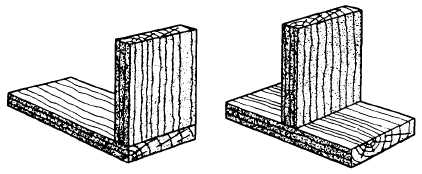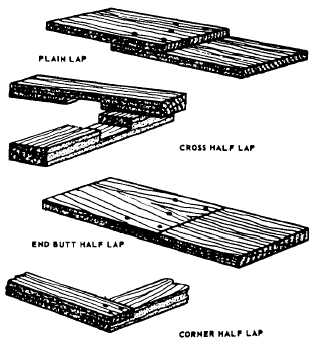
Figure 3-41.-90 plain butt Joints.
WOODWORKING METHODS
LEARNING OBJECTIVE: Upon completing this section, you should be able to identify the various methods and joints associated with woodworking.
In the following section, we will cover some of the methods used by Builders in joining wood.
PLANING AND SQUARING TO DIMENSIONS
Planing and squaring a small piece of board to dimensions is what you might call the first lesson in woodworking. Like many other things you may have tried to do, it looks easy until you try it. The six major steps in this process are illustrated and described in figure 3-40. You should practice these steps until you can get a smooth, square board with a minimum of planing.
JOINTS AND JOINING
One basic skill of woodworking is the art of joining pieces of wood to form tight, strong, well-made joints. The two pieces that are to be joined together are called members. The two major steps in making joints are (1) laying out the joint on the ends, edges, or faces and (2) cutting the members to the required shapes for joining.
The instruments normally used for laying out joints are the try square, miter square, combination square, the sliding T-bevel, the marking or mortising gauge, a scratch awl, and a sharp pencil or knife for scoring lines. For cutting the more complex joints by hand, the hacksaw dovetail saw and various chisels are essential. The rabbet-and-fillister plane (for rabbet joints) and the router plane (for smoothing the bottoms of dadoes and gains) are also helpful.
Simple joints, like the butt (figures 3-41 and 3-42), the lap (figure 3-43), and the miter joints

Figure 3-42.-End butt joints with fishplates.

Figure 3-43.-Lap Joints.
Continue Reading